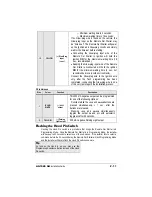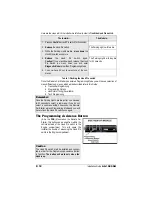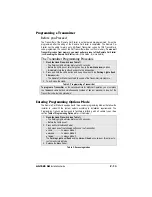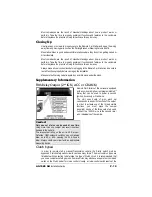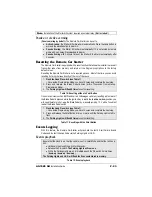
P. 20
Installation
Guide
AS-1585 SH
moment you touch the pedal, whereas a Clutch switch reacts only when the pedal is near
the floor. Once the circuit type is determined, you must recreate, with the Remote Car
Starter, the electrical interaction occurring at the switch in order to bypass the Clutch at the
moment of remote starts. Relays are often used to accomplish this. Always use the Ground
Out When Running (G.O.) wire as the negative trigger on your Clutch bypass relays, as it is
only active during remote starts.
Never carry out a permanent Clutch switch bypass. Do not attempt a bypass at all if you are
unfamiliar with the use of relays and diode isolation.
Before any Hot Wiring attempts:
Test and record the way each wire tests in the following positions:
x
With the pedal up:
test the wire with the Ignition Key in the
OFF
position
test the wire with the Key in the
IGNITION ON (RUN)
position
test the wire with the Key in the
START
position
x
With the pedal down:
test the wire with the Ignition Key in the
OFF
position
test the wire with the Key in the
IGNITION ON (RUN)
position
test the wire with the Key in the
START
position
With this information for every wire at the switch, determining what type of clutch switching
system you have will be easy.
Direct Feed:
The simplest type of system to test and bypass is the “Direct Feed” system. This circuit
simply interrupts the +12 V signal starter wire from the Ignition switch to the starter solenoid.
There are 2 wires in this circuit, the “key side” wire which goes from the clutch pedal to the
Ignition switch, and the “solenoid side” which goes from the clutch switch to the starter
motor. When the key is turned to the
START
position without pressing the pedal, you will test
12 V only on one of the wires at the clutch switch, this is the key side. When the pedal is
pressed down, and the key is the crank position, the other wire will now also read 12 V, this
is the solenoid side wire. To confirm you have a direct feed clutch switch, hot wire the
“solenoid side” wire with fused +12 V, and the starter motor will crank. Connect the starter
output from the Remote Car Starter to the Solenoid side of the wire.
Note:
In the next two systems a Relay in the vehicle interrupts the start wire between the Ignition switch
and the starter motor. With the in the
START
position, and the clutch pedal pressed, the relay
energizes and allows the
START
signal to reach the starter motor. In these systems a wires from
the clutch triggers the relay, when the pedal is pressed. There will be another wire at the clutch
switch that supplies the signal to the trigger wire (either positive or negative, depending on the
system)
Negative Systems:
In a Negative system, when the clutch is pressed; a negative signal is sent to the relay, the
relay energizes, when the Key is turned to the
START
position the 12 V from the start wire is
allowed to pass through the relay and to starter motor. One of the wires at the clutch will test
as negative, this is the supply wire. The relay's negative trigger wire will only show negative
when the pedal is pressed ( some vehicle's also require the Ignition system to be powered).
To confirm you have a Negative system, hot wire the negative trigger wire by jumping it to
a ground source with your fused test jumper. You should now be able to turn the key to the
START
position and engage the start motor, with out pressing in the clutch pedal. If there is






